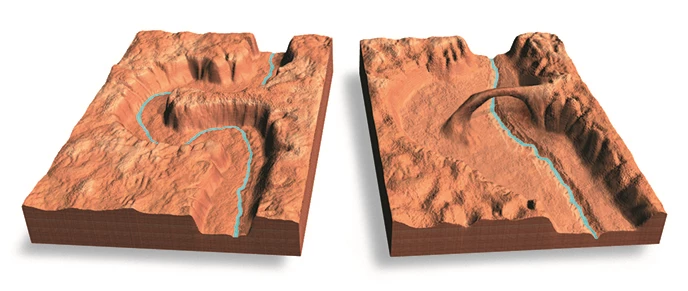|
Rainbow Bridges’ soaring arch has captivated humans for generations. Although it may look similar to many of the sandstone arches also found in the Colorado Plateau, natural bridges are a rarer phenomenon. 
NPS Photo/M. Prachthauser Before Rainbow BridgeThe sandstone that makes up Rainbow Bridge is hundreds of millions of years old. Back when the sediment which makes up the stone was first deposited, the landscape was unrecognizable from what it is today. First, the area was covered by inland seas accompanied by winds that laid down the mud and sand that would form the Kayenta Formation, the stone that creates the base of Rainbow Bridge. The environment eventually changed, becoming dryer, while sand dunes were wind swept into the area. This dry dune field lasted for millions of years and is what created the Navajo Formation, which the span of Rainbow Bridge is composed of. Both of these layers would later be buried under 5,000 feet (1,521 meters) of other rock layers or strata. The weight and pressure of these other rock strata compressed and hardened the rock of the Kayenta and Navajo formations. The Sculpting of a Rainbow of StoneDespite the modern day arid environment, the true sculptor of Rainbow Bridge is water. Before the bridge was formed, the Bridge Canyon stream meandered through the rock taking a path that turned back on itself creating tight curves. The uplift of the Colorado Plateau caused the angle of the stream drainage to steepen. Along with higher rainfall, water started to erode the sandstone. Sandstone, being made of its namesake sand and other sediments, erodes easily as the individual grains of sand are bound together by calcium carbonate, which is water soluble. With the bonds of the stone being dissolved, the flowing water is able to sweep the individual grains downstream. 
With Bridge Canyon stream now at a steeper angle, the water no longer flowed through the bends and around sandstone fins with the path of least resistance; it now was hitting the sides of the fins with more force. The stream eventually forced its way through the fin. Flowing straight through the fin rather than around oxbow bend became the new path of least resistance. The water kept flowing through this new opening, widening it and making it bigger. Eventually it began to resemble the Rainbow Bridge seen today. |
Last updated: January 7, 2026
